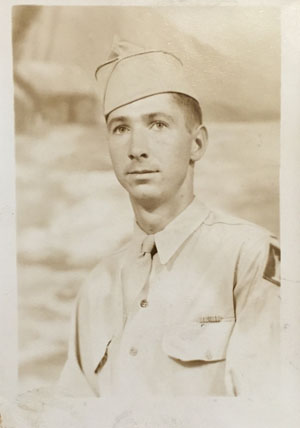
Courtesy Leona Stollings McKinney

Remember...
Wilbur S. Hager
1917-1944
"In peace, sons bury their fathers. In war, fathers bury their sons."
Herodotus
 Courtesy Leona Stollings McKinney |
Remember...Wilbur S. Hager
|
United States Army Private First Class Wilbur S. Hager was born on August 31, 1917, in Ramage, West Virginia, an unincorporated community five miles from Madison in Boone County. His parents were Louthiel Clayton Hager and Rosa Lee Hager. Wilbur had several siblings and half-siblings; two who were identified are Jess Willard Hager and Gladys Hager. A death notice for Willard in the Coal Valley News (February 1, 1945) states that he left behind three brothers and a sister, but other members of the Hager family could not be located. Growing up, Wilbur's nickname was "Hookie." Coming from a coal mining community, Wilbur likely wouldn't have seen much of the economic boom of the "Roaring Twenties" in his early years, but he and his family certainly would have felt the effects of the Great Depression beginning in 1929. Wilbur likely ended his education after grade school and is believed to have worked as a farmer with his father before he enlisted. This occupation would have been necessary for Wilbur to help support his family, especially during the period of economic hardship in the already poor region.
Wilbur had a girlfriend before he enlisted, and the two remained close after he shipped out. They exchanged letters, and Wilbur even sent her a watch from overseas. Although Wilbur's former girlfriend is believed to still be alive, she could not be contacted for assistance in writing this biography.
Wilbur enlisted in the U.S. Army at Fort Hayes in Columbus, Ohio, on December 18, 1940. After shipping out, he spent two years on Bermuda Island. (Source: "Boys Reported Casualties of War Fronts," Coal Valley News, February 1, 1945, p.1.) Although Bermuda was a British territory, the United States had been leased areas of the island for land bases when war in Europe became imminent. As the war continued, Bermuda became a significant asset to the Allies due to the strategic importance of its location and the military installations located there. (Source: Keith Archibald Forbes, "Bermuda's History from 1939 World War 2 to 1951," Bermuda Online, accessed July 16, 2016, http://www.bermuda-online.org/history1939-1951.htm.)
Wilbur's journey would eventually lead him to the island of Guam in 1944. The island, originally an American territory, had been captured by Japan on December 10, 1941. Wilbur was one of over 50,000 Allied troops that launched an assault on the island beginning on July 21, 1944. The Allied recapture of the island began with intensive naval bombardment and the use of demolition teams to clear coral reefs and other obstacles that would hamper landing. After the order to land was given, thousands of American troops swarmed the shores of the island and began the grueling 21-day campaign to recapture the former American territory. Heavy rains and thick jungle made the attack especially difficult for the Allies, as was common in the Pacific Theater. Fighting was not limited to the surface, either. The island housed hundreds of Japanese cave shelters constructed by forced laborers. Guam was declared secure on August 10, 1944, despite the continued presence of several thousand Japanese troops on the island. (Source: Cyril J. O'Brien, "Liberation: Marines in the Recapture of Guam," Marines in World War II Commemorative Series, accessed August 16, 2016, http://www.ibiblio.org/hyperwar/USMC/USMC-C-Guam/.)
After assisting in the recapture of Guam, Wilbur Hager continued his service in the Pacific Theater. Wilbur's next documented location is the Philippine island of Leyte, which was made famous by the battles on land and sea that were fought there. Preliminary operations for the Battle of Leyte began on October 17, 1944, and heavy fighting began three days later. Over 200,000 Allied troops assaulted the island, which had daunting natural fortifications in the form of dense forests, valleys, and extensive networks of ravines and caves. The date of the invasion also posed a challenge, as armies on the island had to deal with monsoons due to the season. Many of the island's residents had previously launched guerilla-style attacks on Japanese troops, as the occupation had brought with it a life of repression for the natives. Thousands of Leyte natives would join the Allied assault and help to retake their home. The Battle of Leyte ended on December 26, 1944, after over two months of heavy fighting. When the battle was over, more than 50,000 Japanese troops had been killed, along with over 3,500 Allied troops killed and thousands more wounded. Wilbur Hager was killed in the fighting on Leyte. It is believed that he was killed by a sniper while leading a platoon of men. (Sources: Charles R. Anderson, "Leyte," U.S. Army Center of Military History, accessed August 16, 2016, http://www.history.army.mil/brochures/leyte/leyte.htm; "Private Hager's Body to Arrive Home Soon," Logan Banner, January 11, 1949.)
Significant gaps exist in Wilbur's narrative. A major reason for this was the inability to locate information on his unit, which would have enabled better tracking of his movements through the war. Leona Stollings McKinney and her husband Frank were kind enough to participate in an interview to provide whatever information they could that would help to fill in the blanks. It is thanks to them that this biography is as full as it is. Wilbur's story is one of immeasurable sacrifice for the good of one's country, and also of the tremendous importance of family in remembering those who went before their time.
Article prepared by Jordan Nistendirk

West Virginia Archives and History welcomes any additional information that can be provided about these veterans, including photographs, family names, letters and other relevant personal history.